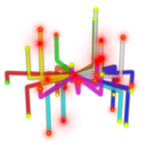Introduction
FTL Travel is only possible outside a significant gravity well. Ships use their FTL drives to enter and travel in Hyperspace, and then effectively fly into the Hyperspace shadow of a gravity well, such as produced by a star or planet, that forces the ship back into normal space. Jumps must be plotted before they are executed. Once in jump space there is no opportunity to maneuver.
Generally the aim is to get the ship to drop out of hyperspace as close to the target as possible while matching heliocentric orbital velocities as conveniently as possible.
To initiate a jump, a ship generally has to be outside the Safe Jump Radius of the origin system’s star and at least 0.05 AU from the nearest planet-sized body (or at least 200 times the planetary radius). The 0.05 AU figure is a Dominion regulatory requirement and the 200 planetary radius an average of a physical one (denser bodies need more range, rarefied bodies, less).
A star’s Safe Jump Radius is reckoned to be approximately 200 times the Solar Radius in AU. The absolute minimum range seems to be about 80 diameters.
Operating a starship is a team effort primarily between the Navigator, the Pilot and the Engineer.
Planets and stars move. While not a huge surprise to anyone, the orbital dynamics of a stellar system can affect how easy or difficult it is to perform a hyperspace jump. Each jump route from a world has changes over time with regard to its difficulty.
All starports in the Dominion publish predictive jump tables, sometimes for hundreds of cycles in advance.
Alternately a Navigator with access to astronomical equipment or positional data for stellar objects can calculate them. This is not a difficult task, but it takes at least a Cycle if there is no positional data available.
It usually takes about 10 Moments to spin up the drives prior to jump. A successful engineering roll may be able to reduce this number in an emergency.
On a typical jump to a terrestrial world ships arrive about 0.7 AU away from their targets, but this can vary substantially.
Time in jump is usually fairly standard, with some random variation. It is not unknown for ships to run a sweep on jump exit time, with the book closing once 10% or 15% of jump has been competed, which is usually when the jump duration is able to be predicted with some accuracy.
Once a jump is made, the FTL drives have to be re-tuned. Which takes about 2 Jobs per drive per engineer.
Emerging from Jump
The jump space drop out is one of the most important times for the Control crew on a starship. The Pilot must be ready to take evasive action in case there is an immediate threat, the Navigator must try and establish the actual location of the ship, the Scan officer must try and determine the nature of local traffic or obstacles to advise the pilot of threats and the Comms officer must try and unscramble the variously time-delayed comms traffic and determine what is going on. The Engineering department is on stand-by in case there are any mechanical issues or emergencies that need attention, but do not usually have any urgent tasks.
Jump Light Lag
Both Comms and Scan are affected by a phenomenon known as Jump Light Lag. This is the result of a combination of two factors:
- emissions reaching the ship’s passive sensor array are limited to travel at the speed of light; and,
- there is no context for any of the signals prior to arrival in system.
It takes time, based on doppler radar data and lateral movement to determine range and direction of anything detected, and any communications picked up from a distant object will be subject to lag as well.
Consider the diagram below:- The instant the ship arrives in system it receives two communications.
- In reality, these signals were generated 500 and 350 seconds ago from ships 1AU and 0.7AU distant, respectively.
- This means communications may be received out of chronological order.
The very long ranges are shown here for effect, and relate mostly to lags in communications traffic. Detection ranges are realistically much shorter. Typically, ships can detect other ships travelling under thrust in open space at a distance of 1 light second (300,000 km) about 75% of the time. Bigger and closer ships are easier to detect, as are ships using active sensors. Smaller ships, ships with stealth masking, on low power, drifting, or with a stellar object such as a star or planet behind them, are more difficult to detect (but noting that bigger ships generally have better sensor arrays). It takes a minimum of 20 seconds to do a complete scan around a ship, taking longer increases the chance of a successful detection.

